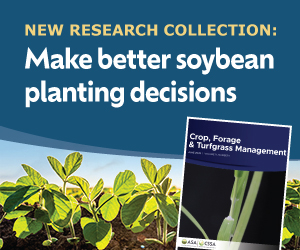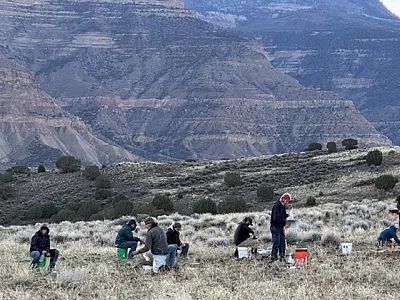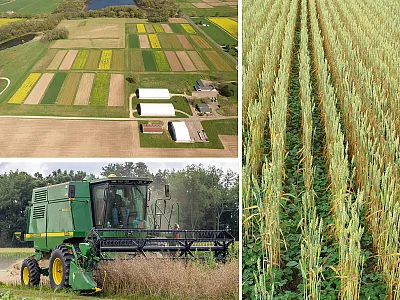UAV-Based Prediction of Sugarbeet Yield and Quality


In Idaho, nitrogen (N) and water management are two major factors affecting sugarbeet yield and quality. If sugarbeet crop yield potential can be accurately predicted early in the growing season, then the crop can be topdressed based on crop nutrient requirements. This approach has the potential to improve the economic returns to sugarbeet growers and processors. The objective of this study was to assess the feasibility of predicting root yield and estimated recoverable sugar using UAV-based normalized difference vegetation index (NDVI) in sugarbeets grown under varied N and water rates. Earn 0.5 CEUs in Crop Management by reading the article and taking the quiz at https://web.sciencesocieties.org Learning-Center/Courses.
Sugarbeet (Beta vulgaris L.) production comprises root yield, sugar (sucrose) yield, and sugar recovery efficiency. In Idaho, nitrogen (N) and water management are two major factors affecting sugarbeet yield and quality.
Low soil N levels can reduce root and sucrose yield, whereas N fertilization in excess of crop need can reduce sugar content and raise the levels of impurities (nitrates), resulting in reduced sugar recovery efficiency. Applying too much N to sugarbeets leads to strong aboveground biomass growth but negatively impacts root development and sugar accumulation. Based on research conducted by the Amalgamated Sugar Company and the University of Idaho, it is typically recommended that growers apply all N preplant to ensure N is available to the crop by the six‐leaf growth stage. On the other hand, literature review has shown that sugarbeet crop need for N is at peak during the time of most intensive leaf growth during June–July (Varga et al., 2022). Some researchers found that N deficiency in sugarbeets could be corrected by topdressing N in June (Gilbert et al., 1981) without yield losses.
Sound irrigation practices (amount and application timing) aim to optimize sugarbeet yield, decrease disease pressure and water costs, and minimize N losses. High irrigation levels increase sugarbeet root size (high root yield), but the larger roots tend to have lower sugar concentration (low sugar yield) (Walsh et al., 2019). Field trials revealed that sugarbeets may tolerate mid‐ and late‐season water stress (Mahmoodi et al., 2008). Water scheduling and deficit irrigation later in the season can result in up to 20% water savings without substantial reduction in sugarbeet yield or quality (Topak et al., 2011).
Studies have shown that N and water uptake by plants is fundamentally interactive (Raun & Schepers, 2008). Crop response to N fertilizer is strongly affected by plant‐available water and vice versa. Soil moisture levels affect N release from applied fertilizers and N mineralization reactions (Zhang et al., 2017). Determining the optimum N fertilizer and supplemental irrigation levels should be based on local data, locally grown varieties, and local production practices.
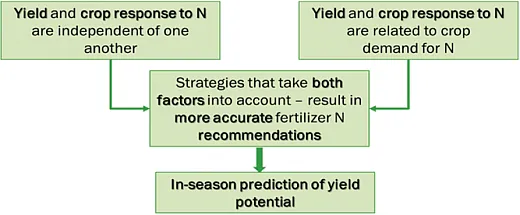
Remote Sensing and UAVs
Precision nutrient and water management is advantageous for optimizing fertilizer and irrigation water inputs because it helps to account for both spatial and temporal variability of crop N demand and supply. Prediction of sugarbeet yield and quality before harvest is important for making agronomic and marketing decisions. Within a variety, in a specific field with specific soil characteristics in a specific environment, sugarbeet crop response to N can be comparable, independent of the yield levels (Figure 1). Harvestable yield is not known until harvest, and N recommendations based on previous yield goals are not always accurate. If sugarbeet crop yield potential can be accurately predicted early in the growing season, then the crop can be topdressed based on crop nutrient requirements. This approach has the potential to improve the economic returns to sugarbeet growers and processors. Remote sensing based on unmanned aerial vehicles (UAVs) is a promising tool for (1) in‐season N and water management and (2) prediction of sugarbeet yield and quality (estimated recoverable sugar, ERS). The normalized difference vegetation index (NDVI) is routinely used in remote sensing for agriculture. The NDVI estimates biomass production of the crop by measuring the difference between near‐infrared light (which plants reflect) and red light (which plants absorb).
Field Trials
The objective was to assess the feasibility of predicting root yield and ERS using UAV‐based NDVI in sugarbeets grown under varied N and water rates. Field trials, funded in part by the Snake River Sugarbeet Research and Seed Alliance, were conducted in Parma, ID, in 2019 and 2020 (Figure 2).
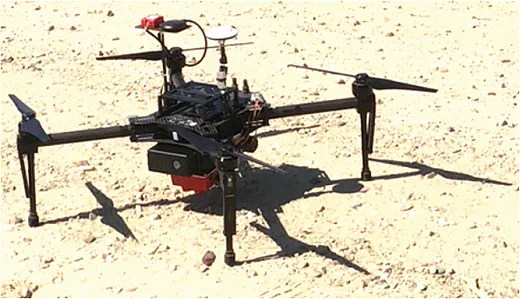
In April, sugarbeets (BTS 2570) were planted at a 22‐inch row spacing and 8‐inch seed spacing into 40‐ft‐long plots each containing four rows. Treatments were arranged in a split‐plot design with four replications. Irrigation was the main plot and N was the subplot. Urea (46–0–0) was applied at planting to achieve three N levels: 100, 200, and 300 lb N/ac (soil residual N plus added fertilizer). Plots were irrigated via a sub‐surface drip irrigation based on daily evapotranspiration (ET) data from the Parma AgriMet weather station. The sugarbeet crop‐specific coefficients were used to guide irrigation events to achieve at two levels: 100% ET (soil moisture lost since the last irrigation replenished fully) and 50% ET (lost moisture replenished at 50% rate). At 40 and 60 days after planting (June and July, respectively), a Matrice 100 UAV (DJI, Los Angeles, CA) furnished with the RedEdge‐M camera (MicaSense, Seattle, WA) was used to acquire aerial images (Figure 3). MicaSense Atlas and Pix4Dmapper image analysis software (Pix4D, Prilly, Switzerland) were used to process the UAV images. In October, sugarbeets were defoliated and harvested; root yield and ERS were measured.
Data were analyzed using SAS statistical software 9.4 (Littell et al., 1996). The effects of N and irrigation rates on sugarbeet root yield and ERS were evaluated. The relationship between UAV NDVI and sugarbeet root yield and ERS were assessed. The effect of N rate on sugarbeet root yield and ERS is reported in Table 1.
| Treatment | 2019 | 2020 | ||
|---|---|---|---|---|
| Root yield (ton/ac) | ERS (lb/ac) | Root yield (ton/ac) | ERS (lb/ac) | |
| 100 N + 50 ET | 26.3 d | 7,657 d | 37.6 a | 11,947 a |
| 100 N + 100 ET | 29.4 c | 8,510 c | 38.7 a | 12,174 a |
| 200 N + 50 ET | 30.2 b | 8,999 b | 44.0 a | 14,123 a |
| 200 N + 100 ET | 33.9 a | 9,927 a | 41.7 a | 13,303 a |
| 300 N + 50 ET | 28.0 c | 8,318 c | 41.4 a | 13,381 a |
| 300 N + 100 ET | 37.7 a | 11,243 a | 40.1 a | 12,827 a |
Note. Values within each column followed by the same letter are not statistically different (95% confidence level).
aET, evapotranspiration.
Results
A combination of 200 lb N/ac plus 100% ET‐based irrigation maximized both sugarbeet root yield and ERS in 2019. There was no significant effect of irrigation and N on sugarbeet root yield and ERS in 2020. Increasing N to 300 lb N/ac did not enhance root yields or ERS in any of the two site‐years (Table 1).
UAV‐based data can be successfully used to accurately estimate sugarbeet root yield (65–91%) and ERS (75–95%) in season. In other words, the images obtained with the UAV transcribed as crop reflectance measurements helped to predict yield and quality of sugarbeets. The accuracy of sugarbeet root yield and ERS prediction from UAV spectral indices has improved from June to July (Figures 4 and 5).
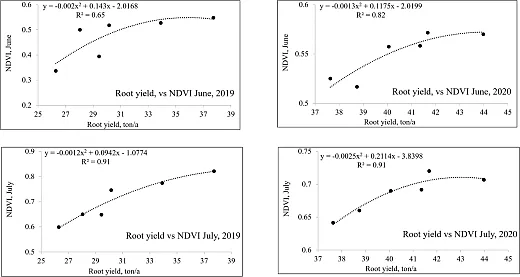
This work serves as a proof of concept that UAV‐based spectral measurements (such as NDVI) can be utilized to predict yield and ERS in season. Further research work should focus on conducting multi‐site‐year trials across the state of Idaho using modern, well‐adapted varieties to develop robust yield and ERS prediction equations. The next step would be building a sensor‐based algorithm for prescribing N fertilizer rates for optimized agronomic, economic, and environmental sustainability of sugarbeet production.
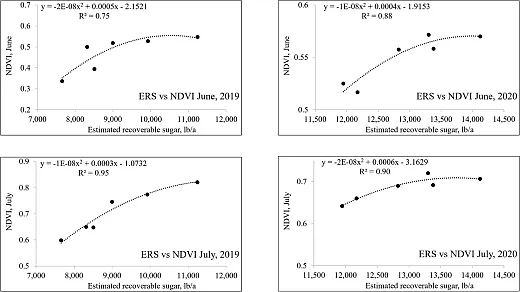
Acknowledgments
The University of Idaho Cropping Systems Agronomy team is thankful to the Idaho sugarbeet growers and the Snake River Sugarbeet Research and Seed Alliance for funding this work.
The continuous support of the University of Idaho sugarbeet research by the Amalgamated Sugar Company is deeply appreciated.
References
Gilbert, W.A., Ludwick, A.E., & Westfall, D.G. (1981). Predicting in‐season N requirements of sugarbeets based on soil and petiole nitrate. Agronomy Journal, 73, 1018–1023.
Littell, R.C., Milliken, G.A., Stroup, W.W., & Wolfinger, R.D. (1996). SAS system for mixed models. SAS Institute.
Mahmoodi, R., Maralian, H., & Aghabarati, A. (2008). Effects of limited irrigation on root yield and quality of sugar beet (Beta vulgaris L.). African Journal of Biotechnology, 7.
Raun, W.R., & Schepers, J.S. (2008). Nitrogen management for improved use efficiency. In Nitrogen in agricultural systems. In J.S. Schepers and W.R. Raun (Eds.), Nitrogen in Agricultural Systems (pp. 675–695; Agronomy Monograph 49). American Society of Agronomy.
Topak, R., Süheri, S., & Acar, B. (2011). Effect of different drip irrigation regimes on sugar beet (Beta vulgaris L.) yield, quality and water use efficiency in Middle Anatolian, Turkey. Irrigation Science, 29, 79–89.
Varga, I., Jović, J., Rastija, M., Markulj Kulundžić, A., Zebec, V., Lončarić, Z., Iljkic D, Antunovic M, & Antunović, M. (2022). Efficiency and management of nitrogen fertilization in sugar beet as spring crop: A Review. Nitrogen, 3, 170–185.
Walsh, O.S., Tarkalson, D., Moore, A., Dean, G., Elison, D., Stark, J., Neher O, & Brown, B. (2019). Southern Idaho fertilizer guide: Sugar beets (Bulletin 935). The University of Idaho.
Zhang, H.Z., Khan, A., Tan, D.K.Y., & Luo, H.H. (2017). Rational water and nitrogen management improves root growth, increases yield and maintains water use efficiency of cotton under mulch drip irrigation. Frontiers of Plant Science, 8, 912.
Self-Study CEU Quiz
Earn 0.5 CEUs in Crop Management by taking the quiz for the article at https://web.sciencesocieties.org/Learning-Center/Courses. For your convenience, the quiz is printed below. The CEU can be purchased individually, or you can access as part of your Online Classroom Subscription.
- Currently perennials
- invest more carbon reserves below ground.
- do not produce human edible food in high enough quantities.
- do not compete well with weeds.
- require annual seeding.
- How much of the rye grain harvest in the United States is used as pasture, hay, or as a cover crop?
- Quarter.
- Half.
- Three-fourths.
- All of it.
- Which rye cultivar in this study had the highest protein content?
- ACE-1 PC.
- Gazelle.
- Hazlett.
- Benton.
- Higher tiller productivity is a common attribute in perennials.
- True.
- False.
- The ACE-1 PC grain yield diminished after the first year at both locations.
- True.
- False.
Text © . The authors. CC BY-NC-ND 4.0. Except where otherwise noted, images are subject to copyright. Any reuse without express permission from the copyright owner is prohibited.



